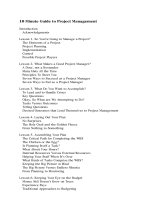management alpha 10 Minute Guide to Project Management PHẦN 6 docx
Bạn đang xem bản rút gọn của tài liệu. Xem và tải ngay bản đầy đủ của tài liệu tại đây (85.59 KB, 13 trang )
having to use plants and equipment to the max.
● In some organizations the most careful and comprehensive project budgets end up being
slashed by some senior managers or executives who are operating based on some
agenda to which you are not privy. In his book The New Project Management, author J.D.
Frame says, "Political meddling in cost and schedule estimating is an everyday occurrence
in some organizations." The best antidote against such meddling, says the author, is "the
establishment of objective, clearly defined procedures for project selection …" which
should be set up so that no one, "no matter how powerful, can unilaterally impose their will
on the selection process."
The issues raised in this lesson point to the ever present need for project managers to build an
appropriate degree of slack into their estimates. This is not to say that you are being dishonest or
disloyal to your organization, but rather acknowledging the ruthless rules of project management
reality—you hardly ever get the funds you need, and even then, stuff happens!
The 30-Second Recap
● Because of irrational exuberance, too often the monetary resources allocated to a project
(perhaps even before you stepped aboard) have been underestimated.
● In most organizations, no matter how much you ask for, you can count on not getting it all.
● Perhaps the most effective approach to budgeting combines the top-down and bottom-up
techniques.
● Build an appropriate degree of slack into your estimates!
Lesson 7. Gantt Charts
In this lesson, you learn what a Gantt chart is, why it is so useful in project management, variations
you can devise, and how to use Gantt charts to keep your project on schedule.
Chart Your Progress
Henry L. Gantt, for whom the Gantt chart is named, was employed at the Aberdeen Proving
Grounds (part of what is now the U.S. Department of Defense—then called the War Department)
in Aberdeen, Maryland—as an ordinance engineer during the First World War. Although nearly a
century has passed, the Gantt chart remains widely recognized as a fundamental, highly
applicable tool for project managers everywhere. A Gantt chart enables you to view start and stop
times easily for project tasks and subtasks.
TIP
Gantt charts are derived from your work breakdown structure (WBS).
If you use an outline for your WBS, the Gantt depicts each of the tasks and subtasks in
chronological order. For tasks that begin at the same time and run concurrently, the Gantt chart is
a highly convenient tool. However, over-lapping tasks and subtasks can easily be depicted on the
Gantt chart as well.
A WBS is created from tree diagrams, which also lend themselves to depiction on a Gantt
chart—although the process is a bit tricky when it comes to determining overall project sequence
and start and stop times. (More on converting tree diagrams to critical path analysis in Lesson 8,
"PERT/CPM Charts." )
Two basic forms of Gantt charts are depicted here. The following chart uses bars extending from
left to right along the horizontal axis to denote starting and ending times for events or activities.
Greater detail could be added if you wish to add subtasks. Color-coding allows you to pinpoint
which project workers are handling which tasks and subtasks. The chart shown in the following
figure offers a simple plan for depicting the planned sequence of events versus the actual (the
shaded bars). It is a rare project indeed where the brunt of the planned events or tasks are closely
mirrored by the actual performance and completion of them:
A Gantt chart with bars.
The chart shown in the next figure is merely an alternative to the previous one. Rather than using
bars to depict start and stop times and shaded bars to depict actual performance versus planned
performance, this chart uses
● Unshaded triangles pointing up to depict plan start time
● Unshaded triangles pointing down to depict plan end time
● Shaded triangles pointing up to depict actual start time
● Shaded triangles pointing down to depict actual completion time
A Gantt chart with triangles.
One of the advantages of preparing a Gantt chart in this format is that tasks and subtasks, and
planned versus actual timeframes can be depicted on a single line emanating from the left of the
chart, extending out along the horizontal axis to the right.
The two variations of the Gantt chart depicted above (there are many others), offer a snapshot of a
project's progress based on timeframes.
In the first figure, although Task 1 didn't start on time, its duration was roughly equal to the original
planned time.
In Task 2, however, the start time was not only delayed, but the actual completion time for the task
was far greater than originally planned. This could signal potential budgetary problems or human
resource bottlenecks here or at other points as the project progresses.
If the start of Task 3 is not dependent upon the results of Task 2, then the manager can make a
decision to initiate Task 3 as scheduled or even earlier, since delays in starting Task 2 may
indicate the availability of idle resources.
If Task 3, however, is dependent upon the completion of Task 2, or at least the brunt of it, then the
project manager may have no alternative but to have Task 3 start late as well. You can see that
the delays in Task 1 and Task 2 may have a cascading effect which puts all project activities
behind schedule unless the project manager is able to reallocate resources so as to pick up the
slack where possible.
Variations on a Theme
The Gantt chart in the following figure for a construction project depicts an eight-week period that
includes four events, three of which are actual tasks and one representing completion of the
project. Each of the three tasks has between four and six subtasks. Virtually all project activity is
dependent upon maintaining the sequence of events as depicted.
The coding at the bottom of the chart indicates critical and noncritical progress related and
management critical events.
● Scheduled start and stop times for the duration of tasks are earmarked by solid, downward-
pointing triangles emanating from the start and end of progress bars.
● Milestones are depicted by dark diamonds.
● More detail could be added to this chart in the form of other kinds of lines and symbols.
The project manager for this chart probably found this level of coding to be useful and convenient
for his purposes.
TIP
Each of the three Gantt charts depicted thus far represent plainly evident ways of
illustrating overall project status while including the status of each task. Thus, they
serve as valuable tools for keeping project team members abreast of activities, as
well as the authorizing party, committees, top managers and executives, and other
stakeholders.
A Gantt chart for sequential construction.
Embellishments Offer Detail
The more tasks involved in your project and the more important the sequence between tasks, the
greater your propensity to embellish your Gantt chart. The chart in the next figure contains some
highly useful added columns.
A Gantt chart with multiple predecessors.
● Column 3,"duration," lists how many days each task is scheduled to take.
● Column 4, "predecessors," identifies what needs to be completed before this task can be
initiated.
Often the previous task needs to be completed, but this isn't always the case:
● For the purchasing Task 7, both Tasks 5 and 6 need to be complete.
● For Tasks 8, 9, and 10, only Task 7 needs to be complete, as Tasks 8, 9, and 10 all start at
the same time.
● For Task 12, "install software," Task 10 needs to be complete, but Task 11, which is
scheduled to start after, does not.
You may wonder, "Why not switch Tasks 11 and 12 in the Gantt chart?" The answer is that Task
11, "developed training," follows directly from the completion of Task 8, "manuals"—whereas Task
12, "install software," directly follows from the completion of Task 10, "set up server." They are
listed in sequence on the Gantt chart based on what they follow, not based on when they start.
One of the benefits of listing the task duration in days is that it also gives you a strong indicator of
required levels of staff support. In the simplest example, if all staff members have the same
capability, and a ten-day project requires one staff person per day, you could simply add the total
number of days in the duration column and get a total number of staff days necessary for the
project.
CAUTION
Leave yourself (as project manager) out of the duration computation, because you
are fully involved in management and not engaged in any individual task.
The challenge gets more complex when two, three, four, or more staff people are needed per task
for each day of a task's duration or, when varying numbers of staff people are needed per task, per
day. It gets complicated further if the skill levels of project staff vary widely.
TIP
Project management software solves many issues related to multiple resource
complexity. First, however, you have to understand the basics with paper and
pencil, just as you have to learn the fundamentals of math on your own before
being able to successfully use a calculator.
Getting a Project Back on Track
Whenever you find yourself falling behind in one area, you have to make managerial decisions as
to how you will compensate to keep the overall project on track. This involves a shuffling of
resources, altering the scope of selected tasks or subtasks, or changing sequence of tasks. Let's
visit each of these.
● Reallocating Resources
It happens to the best of project managers. You launch into a task, and soon enough you
find yourself under-resourced. You didn't know that a particular task or subtask was going
to be so challenging. If it's critical to the overall project, it makes sense to borrow resources
from other task areas.
● Reducing the Level of Effort on Tasks or Subtasks
Just as you discovered that some tasks clearly mandate greater staff resources, you may
also find tasks and subtasks that could be completed with less effort than you originally
budgeted. Perhaps some subtasks can be combined, or skipped all together. For example,
if you're doing survey work, perhaps you can get a reasonable result with eight questions
instead of 10. Perhaps you can reduce the total number of interviews by 10 percent.
● Altering the Task Sequence
Another possibility when faced with roadblocks is to change the sequence of tasks or
subtasks. Can you substitute easier tasks for more challenging ones until some of your
other staff resources are free? Perhaps you can devise a sequence that enables some of
your more experienced staff members to manage multiple tasks for a brief duration.
Thinking Ahead
The Gantt chart is a useful device for engaging in "what-if" questions. As you look at the sequence
of events, their duration, and the number of allotted staff days, sometimes you see opportunities to
make shifts in advance of the need. Such shifts may help things to run more smoothly down the
road.
TIP
If you find that the first several tasks or subtasks to your project are already falling
behind, a Gantt chart can help you identify where else this may happen given your
operating experience. Hence, you can begin crafting alternative
scenarios—alternative Gantt charts that may prove to be more effective for
managing the duration of the project.
You may have the pleasant experience of having tasks and subtasks completed in far less time
than you had originally plotted. So, use the Gantt chart to reschedule subsequent events, moving
them up and taking advantage of the temporary gains that have already been realized.
In summary, the ease of preparation, use, alteration, and sheer versatility of Gantt charts makes
them a marvelous tool for both managing your project and depicting your progress to others.
The 30-Second Recap
● The Gantt chart is widely recognized as a fundamental, highly applicable tool for project
managers to enable one to easily view start and stop times for project tasks and subtasks.
● The more tasks involved in your project and the more important the sequence between
tasks, the greater your propensity and desire to embellish your Gantt chart.
● The Gantt chart helps answer "what-if" questions when you see opportunities to make
shifts in advance of the need.
Lesson 8. PERT/CPM Charts
In this lesson, you learn why projects get increasingly complex, the fundamentals of PERT and CPM charts, why PERT and CPM charts are
inexorably linked, and how to use the critical path method to conserve resources.
Projects Can Get Complex
Complexity happens more often than we care for it to happen. Take the case where you are managing a two- or three-person team. If it is
you and another person, you have only one other connection between the two of you. With three people on a project you have three
connections. One between you and person A, another between you and person B, and one between person A and B (see the figure below).
Oh, if only things stayed that simple.
Two people, one connection and three people, three connections.
When there are four people on a project there are six connections, and with five people, there are ten connections, as shown in the following
figure.
Four people, six connections and five people, ten connections.
When there are six people on a project there are 15 interpersonal connections, and when there are seven people on a project there are 21.
This simple mathematical algorithm reveals that on a project beyond four or five people, the number of interconnections grows rapidly and
can even become unwieldy. Now suppose that you have a vital piece of equipment that needs to be shared among several of your project
staff. Throw in some other resource constraints as to when they can use that piece of equipment, when the equipment needs to be
maintained, and the probability of it being unavailable for repair time.
Now, add a second resource, such as another piece of equipment, access to a database, or reliance upon a survey in process. Pretty
quickly, with a lot of people on your project team, and with time, money, or resource constraints, effective management can get very involved
in a hurry. Throw in some tasks that are dependent upon completion of previous tasks and you have the recipe for bottlenecks, roadblocks,
and potentially massive project inefficiencies.
TIP
Complexity as project resources grow is not anybody's fault. It is just the nature of numbers, interconnectedness, restraints,
and dependencies.
The Gantt chart, discussed in Lesson 7, is a valuable tool particularly for projects with a small number of project team members, the project
end approaching, and few project constraints. For larger, longer-term projects involving many people, resources, and constraints, project
managers need more sophisticated tools for maintaining control.
Plain English
Project constraint
A critical project element such as money, time, or human resources, which frequently turns out to be in short supply.
Enter the PERT and CPM
The Program Evaluation and Review Technique, widely referred to and hereafter exclusively referred to as PERT, offers a degree of control
that simply becomes essential for many projects. Using PERT, a project manager can identify a task or set of tasks that represent a defined
sequence crucial to project success.
A second project management technique whose fundamental approach is close to PERT is called the Critical Path Method, or CPM. The
critical path in a project is the one that takes the longest to complete. So, the critical path never has any slack. If you fall behind along the
critical path, the whole project falls behind schedule.
TIP
Even if you never have to engage in PERT/CPM analysis, it's good to know the fundamentals.
PERT was developed by Booz—Allan Hamilton and the Lockheed Corporation in participation with the U.S. Navy on their Polaris
Missile/Submarine project back in 1958. CPM was developed by Dupont Incorporated around the same time. While each approach has
individual features, for our purposes they are close enough to treat them as virtually one and the same, so hereafter, we will refer to
PERT/CPM as a unified approach to project management.
TIP
Project managers have used PERT/CPM to compress project schedules by identifying which tasks can be undertaken in
parallel, when initially it may have appeared that they needed to be undertaken sequentially—a valuable capability.
PERT/CPM enables a project manager to address issues such as
● What will happen during the project if a noncritical task slips by two weeks?
● What will happen if a critical task slips by a few days and ends up starting at the same time as another critical task?
● If I have to keep project staff on one task for an extra three days, how will it impact all remaining tasks?
Plain English
Critical task
A single task along a critical path.
Noncritical task
A task within a CPM network for which slack time is available.
A Short Course
By definition, the critical path always represents that path that takes the most time to complete. So, the critical path never contains any slack.
Delays along the critical path impact the entire project. Tasks not on the critical path, by definition, always have some slack in their
completion time.
CAUTION
Those assigned to noncritical path tasks don't have to work quite as diligently as those on the critical path. If they are not
careful, however, their total duration can exceed that of the critical paths, and thus they could put the project behind as well.
Keeping in mind that this is the 10-Minute Guide to Project Management and not a 480-page tome, let's look at how you could use
PERT/CPM to manage a simple project. We'll keep it to 10 events or tasks, including a start and an end, so only eight tasks require attention.
There will only be two people on this project, you and a friend.
1. Create a work breakdown structure for the project. The following figure will serve as our example:
Work breakdown structure (WBS).
In this example, the path that takes the most time is Task 10, the drive to the outing site.
2. Using the information in the WBS, create a flow chart such as that depicted in the next figure. Notice that in this flow chart some tasks
can occur simultaneously. The tasks that Bill works on are depicted above, and the tasks Erica works on are depicted below.
PERT/CPM network.









